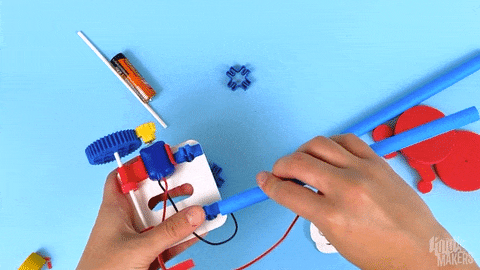Strawbots
(accessible from your profile page)
Explore balanced and unbalanced forces in a motorized wiggling machine! Built, test, and iterate on your solution until it moves how you'd like - or connect yours with other Strawbots to create a collaborative mega bot! Promote curiosity, perseverance, and collaboration in this playful engineering design challenge.
Here's everything you'll need to coach with confidence!
Coaching Guide
Resources
Standards Alignment
Recognize and draw shapes having specified attributes, such as a given number of angles or a given number of equal faces.5 Identify triangles, quadrilaterals, pentagons, hexagons, and cubes.
Measure and estimate liquid volumes and masses of objects using standard units of grams (g), kilograms (kg), and liters (l).6 Add, subtract, multiply, or divide to solve one-step word problems involving masses or volumes that are given in the same units, e.g., by using drawings (such as a beaker with a measurement scale) to represent the problem.
Solve real world and mathematical problems involving perimeters of polygons, including finding the perimeter given the side lengths, finding an unknown side length, and exhibiting rectangles with the same perimeter and different areas or with the same area and different perimeters.
Recognize angles as geometric shapes that are formed wherever two rays share a common endpoint, and understand concepts of angle measurement:
Relate volume to the operations of multiplication and addition and solve real world and mathematical problems involving volume.
Understand that shapes in different categories (e.g., rhombuses, rectangles, and others) may share attributes (e.g., having four sides), and that the shared attributes can define a larger category (e.g., quadrilaterals). Recognize rhombuses, rectangles, and squares as examples of quadrilaterals, and draw examples of quadrilaterals that do not belong to any of these subcategories.
Draw points, lines, line segments, rays, angles (right, acute, obtuse), and perpendicular and parallel lines. Identify these in two-dimensional figures
Understand that attributes belonging to a category of two- dimensional figures also belong to all subcategories of that category. For example, all rectangles have four right angles and squares are rectangles, so all squares have four right angles.
Explain how specific images (e.g., a diagram showing how a machine works) contribute to and clarify a text
Use information gained from illustrations (e.g., maps, photographs) and the words in a text to demonstrate understanding of the text (e.g., where, when, why, and how key events occur).
Refer to details and examples in a text when explaining what the text says explicitly and when drawing inferences from the text.
Quote accurately from a text when explaining what the text says explicitly and when drawing inferences from the text
Use context to confirm or self-correct word recognition and understanding, rereading as necessary.
Recount or describe key ideas or details from a text read aloud or information presented orally or through other media.
Engage effectively in a range of collaborative discussions (one-on-one, in groups, and teacher- led) with diverse partners on grade 3 topics and texts, building on others’ ideas and expressing their own clearly
Pose and respond to specific questions to clarify or follow up on information, and make comments that contribute to the discussion and link to the remarks of others.
Follow agreed-upon rules for discussions and carry out assigned roles.























